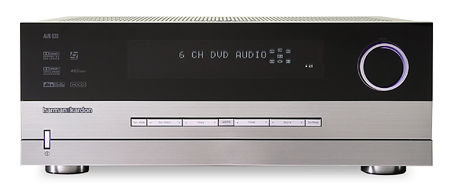Harman/Kardon AVR 630 Receiver

Basic black seems to be losing its luster among trend-conscious manufacturers. For disappearing in the dark, it's the strongest color; however, for users of front-panel controls, it's often the most frustrating. H/K compromises by sticking with black for the top half of the front panel, including the display, and lightening up the bottom. That makes it easier to read the legends for (or just to find) the row of front-panel buttons provided in lieu of a jog dial. You can select inputs and surround modes using 1.5-inch-long, two-sided rocker switches. Finding the volume knob is easy because it's outlined by a cute, round, blue LED glow.
This one's got the staple surround modes, plus a few more. There are two different modes for simulating surround-like effects from two speakers: Dolby Virtual Speaker, which acts directly on signals in Dolby's formats, and Harman's own VMAx. For headphone listeners, Dolby Headphone performs various feats of DSP magic seemingly in your head; it changes the quality of the space occupied by voices and instruments, although it also adds a processed feeling. A free software update via the RS-232 port will upgrade Dolby Pro Logic II to IIx. Harman's Logic 7 converts 2.0 to 7.1 with its own distinctive matrixing circuitry, which also appears in Lexicon products; H/K's are the only receivers to feature it.
 H/K was the earliest adopter of the auto-setup process, and they include it here. But wait, where's the mic? Doesn't H/K supply one? Look carefully for three holes at the top of the remote, and there it is. The EzSet routine spits out test tones and adjusts each channel's level accordingly. It affects speaker levels only; it doesn't detect the speakers' size and placement. But it's still a whole lot easier than having to raid the kids' college fund for $40, go out to RadioShack, buy an SPL meter, load it with a nine-volt battery, learn how to use it, actually use it, and then put it in a drawer to remain untouched for years—if in fact you ever use it again or even remember it's there.
H/K was the earliest adopter of the auto-setup process, and they include it here. But wait, where's the mic? Doesn't H/K supply one? Look carefully for three holes at the top of the remote, and there it is. The EzSet routine spits out test tones and adjusts each channel's level accordingly. It affects speaker levels only; it doesn't detect the speakers' size and placement. But it's still a whole lot easier than having to raid the kids' college fund for $40, go out to RadioShack, buy an SPL meter, load it with a nine-volt battery, learn how to use it, actually use it, and then put it in a drawer to remain untouched for years—if in fact you ever use it again or even remember it's there.
Also missing from the AVR 630 is room EQ. However, it would be unjust to say that Harman hasn't got this angle covered. At least for the time being, the company's institutional point of view is that EQ is best limited to bass frequencies. For that purpose, Harman's Infinity brand offers the CWS-10 and SW-12 subwoofers with adjustments for EQ frequency, level, and width—and the street-price differential would just about pay for the sub. For more information on why equalizing frequencies above 250 hertz might be a bad idea, read the white paper from Meridian (not part of the Harman empire): www.meridian-audio.com/w_paper/Room_Correction_scr.pdf.
The Harman sound is as familiar to me as my sisters' voices. The slightly warm, carefully sculpted midrange is designed for maximum intelligibility. Dynamics are better than you'd expect, given the manufacturer's conservatively quoted 75-watts-per-channel power rating. Most manufacturers quote at least 100 wpc even for their lowest priced weaklings, but this one doesn't insult the intelligence with magic numbers; instead, H/K provides an "all channels driven" spec. A 41-pound receiver with ventilation holes on three sides should muster a fair amount of current.
All surround receivers—including the four reviewed here—are subject to some degree of clipping when asked to produce more power (aka higher volume levels) than they're capable of. Even if you are routing all bass below 100 Hz to your subwoofer (I actually used a more-taxing 80-Hz crossover), feeding seven woofers and seven tweeters will challenge a power supply that's small enough to share a box with a lot of other circuitry. The secret strength of Harman/Kardon receivers is the manner in which they clip on relentless material like The Matrix Revolutions. Run this receiver near the top of its volume capability, and it maintains its character. The sculpted midrange doesn't suddenly lose its shape.
- Log in or register to post comments






























































